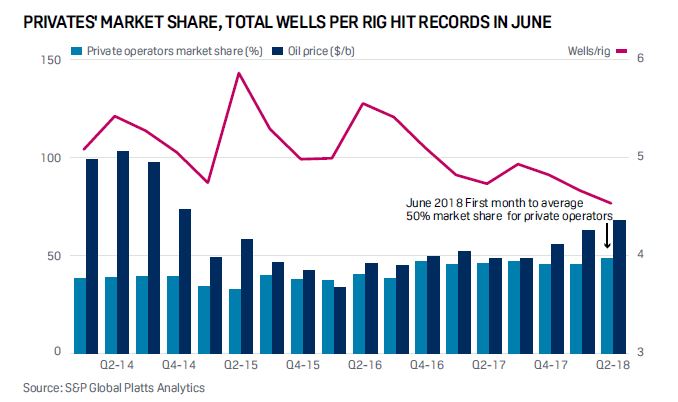
Source: Rigs and Drilling Analytical Report (RADAR, July 12, 2018), S&P Global Platts Analytics
June Records for Private Companies' Market Shares, New Wells Drilled Per Rig Show Increasing Uniformity of Drilling
As if to underscore the upending of traditional behavior by the
evolving
private oil and gas sector, the month of June
ushered in a pair of records: the
highest monthly market share on record for
private companies and the lowest
number of new land wells drilled per rig by
all companies.
Traditionally—at least since we started
tracking such metrics—private
operators held their share of the market to
less than 40% of all active rigs. This was
irrespective of the rig count total and/or oil
and gas commodity prices. From 2011 to mid-2016,
the privates’ market share held steady at an
average of 38%, ranging from 30% to 43%. Out of 124 reports on this metric, the privates’
market share had breached 40% only 24
times.
Since June 2016, the 53 market share reports show the privates have averaged a market share of 46%, topping 44% every single time. And it averaged more than 50% for the entire month of June, another first.
Typically, privates have built their market
share gradually through the
year, peaking in Q3, depending on the direction of commodity prices. Their
rig counts and well counts were usually smaller in the first quarter of year as
they secured financing for drilling programs,
then they would taper off
in Q4 or late Q3 as they spent down their
drilling programs for the year to
minimize the tax bite.
FREE TRIAL OFFER
Receive a free one month trial of RADAR (4 issues). Each week you'll receive the latest analysis of unconventional activities and general trends in the upstream market. Operators are categorized by the major shale plays and unconventional formations where activity is occurring. Plus, you'll see the drilling contractors involved by play with details on utilization, footage and market share. (Available in pdf and Excel format.)
Call 800-371-0083 or email CustomerService.RigData@spglobal.com.
Mention code 7HHONRPT
Because of this behavior, the number of wells
per rig would move up in
accordance with a surging market for private operators. The nearby
chart
shows the quarters from 2014 inclusive through
2Q 2018, reflecting the boomand-
bust iterations of the worst downturn for the oil and gas industry. Up until
that
point, oil prices were at lofty levels well above where they are now, and
natural
gas prices were at record highs. A great deal of stability had permeated
the
market on drilling for both resources, and the privates’ drilling market
share
had moved up in steady increments during the post-2009–2010 bust.
At the same time, corresponding with that development, the number of
new wells drilled per rig would peak with the privates’ market
share—all
else being equal on commodity prices. That’s because the privates were
focused
on conventional reservoirs with vertical wells. Because vertical wells
usually are
drilled much faster, the nimble smaller, private companies could drill
more
wells per rig than the larger, usually public companies did. Even if you
had
3 rigs or fewer—the rig fleet category long dominated by small
privates—you
could drill wells more quickly and have a greater number of wells per rig.
Thus
the number of wells per rig would wax and wane in synch with the
privates.
And that gap only grew as larger companies focused more on
increasingly complex horizontal wells. It was especially so as larger
operators
high-graded their drilling locations and executed ever more complex
horizontal
wells in pursuit of return instead of
growth.
No more. Our latest quarterly well counts report will be published Friday
the 13th of July, and the evidence is clear: For the first time we see private
operators’ market share has reached unprecedented high levels, and yet the
number of rigs per well have plummeted to unprecedented low levels.
That can only mean that the cohort of private operators has become
increasingly tilted to companies focused on horizontal wells. And at last
report,
horizontal wells now accounted for about 88% of the market. As long as
that
metric holds—and we see no reason why it shouldn’t and even get
bigger—the
number of wells drilled per rig will slip.Because of the expanding ubiquity
of
horizontal wells, even as this ostensibly traditional marker for drilling
efficiency
declines, the production impact will become commensurately greater.
Upstream Activity Data for North America
For more information on North American upstream activity including permitting, drilling activity, production and completion data please contact S&P Global Platts via email CustomerService.RigData@spglobal.com or call 800-371-0083.
